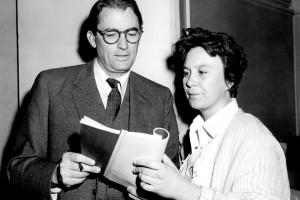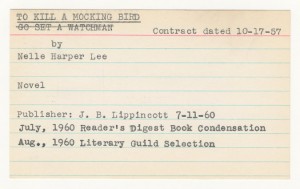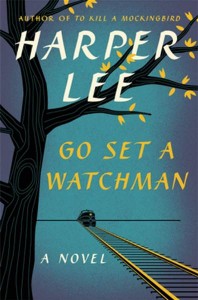Since several news outlets have referred to it as such, it’s safe to say that the release of Harper Lee’s Go Set a Watchman is one of the most unexpected, curious, and pivotal releases in modern publishing history. And today is the day, beloved patrons, that history is made.
The world at large was stunned in February when it was first announced that Lee had penned a sequel to To Kill A Mockingbird, a work that has been hailed as America’s “national novel”, which tells the story of Scout, a wonderfully intelligent and empathetic six-year-old, and her brother Jem, in the “tired old town” of Maycomb, Alabama with their widowed father, Atticus Finch. When Atticus is appointed to defend Tom Robinson, a black man accused of raping a white woman, Scout becomes witness to both the best and the worst extremes of human behavior; from the noble defense and relentless compassion of Atticus to the murderous and vengeful reactions of her closest neighbors. Though it deals with some genuinely difficult themes and dark subject matter, this book is noteworthy for its sympathy and humanity, as well as for the way it deals with courage in the face of ignorance, fear, and prejudice. Lee’s narrative style, which Time magazine called “tactile brilliance”, brings the world of Maycomb to life through the eyes of a precocious child who is clearly marked forever by the events of Tom Robinson’s trial.

The book was an immediate sensation, and although it met with sharp criticism from many Southern reviewers. It won the Pulitzer Prize in 1960, and in 1962, was adapted into an Oscar-winning film, starring Gregory Peck as Atticus Finch in a role that would forever define his career (Lee thought Peck so embodied her father, who was the model for Atticus, that she gave him her father’s pocket watch). By 1964, however, Lee was so overwhelmed and exhausted by the attention both she and her book received that she refused all press requests. Since then, the book has gone on to be a classic, as famous for its subject matter as for the reclusive nature of its shy author.
Hence the genuine shock–and intense doubt– that resulted from the announcement that Harper Lee had penned a second book about Atticus, Scout, and Maycomb. Many claimed that Lee, who is currently 89 years old, and suffers from failing hearing and vision. was a victim of elderly abuse, and was being coerced into publishing the book. News coverage was so intense that the Alabama Securities Commission investigated the situation, eventually concluding that Harper Lee was fully cognizant of the publication of her long-hidden novel, and eager for its release. Shortly thereafter, Lee released a statement through her publisher, Harper Collins, stating, “In the mid-1950s, I completed a novel called ‘Go Set a Watchman. It features the character known as Scout as an adult woman, and I thought it a pretty decent effort…My editor, who was taken by the flashbacks to Scout’s childhood, persuaded me to write a novel (what became ‘To Kill a Mockingbird’) from the point of view of the young Scout. … I am humbled and amazed that this will now be published after all these years”.
But reactions to Go Set A Watchman will very likely be mixed, as expectations collide with reality, and inevitable comparisons are drawn between this book and Lee’s immortal Mockingbird. Last Sunday, London’s Guardian and The Wall Street Journal released the first chapter of the book to an eager public (you can read it here), and the results can only be described as collective bewilderment, particularly by those who expected the tone and feel of Watchman to emulate Mockingbird. Instead, we find an adult Jean Louise (Scout’s real name, apparently), a resident of New York, who is returning home to visit her father, who is crippled by rheumatoid arthritis. Her brother Jem is dead, and Jean Louise is nearly engaged to her lifelong friend Henry Clinton. The story is told in the third-person, creating a completely different relationship between the reader and the world of the story. But the real shock comes from the changes in Atticus. From what we have been told, gone is the compassionate moral compass of Mockingbird, and in his place is…a very different man indeed.

Perhaps because Watchman has been so heavily touted as a ‘sequel’ to Mockingbird that many are finding the premise, and the events of the book, so difficult to digest. Perhaps it may be helpful to remember (assuming that everything that has come out of Harper Collins’ press department is true) that Watchman actually came first. When she read the manuscript for Watchman in 1957, Lee’s editor told her to write Mockingbird instead, thinking that the views of a time long past might appeal to readers more than a commentary on contemporary events, and that a child’s view might soften the view of an ongoing debate over civil rights. The country was convulsed by issues such as the desegregation of school, the rise of the NAACP, and the visceral, often violent indignation of those who feared their own power slipping away, and Mockingbird spoke to those issues without confronting them directly. What we see in Watchman is a world where the Civil Rights Movement was proving as divisive as it was powerful, and exhausting even the most well-intentioned as wave after wave of protests and marches were met with water cannons, billy clubs, and hatred, a world where generation gaps became gulfs of misunderstanding, hostility, and indignation.
Thinking about Scout/Jean Louise and her world in this light, and considering Mockingbird as a kind of prequel to Watchman, instead of the other way around, makes these two books into a heart-rending, but timely commentary on the cost of idealism, the complicated relationships we have with our own pasts, and the realities of race relations in the United States. The timing of this publication could not be more timely, or more poignant, and the ongoing debate over the lowering of the Confederate Flag in South Carolina only serves to remind us of how far we have come…and, like Jean Louise herself, how far we have yet to go.


